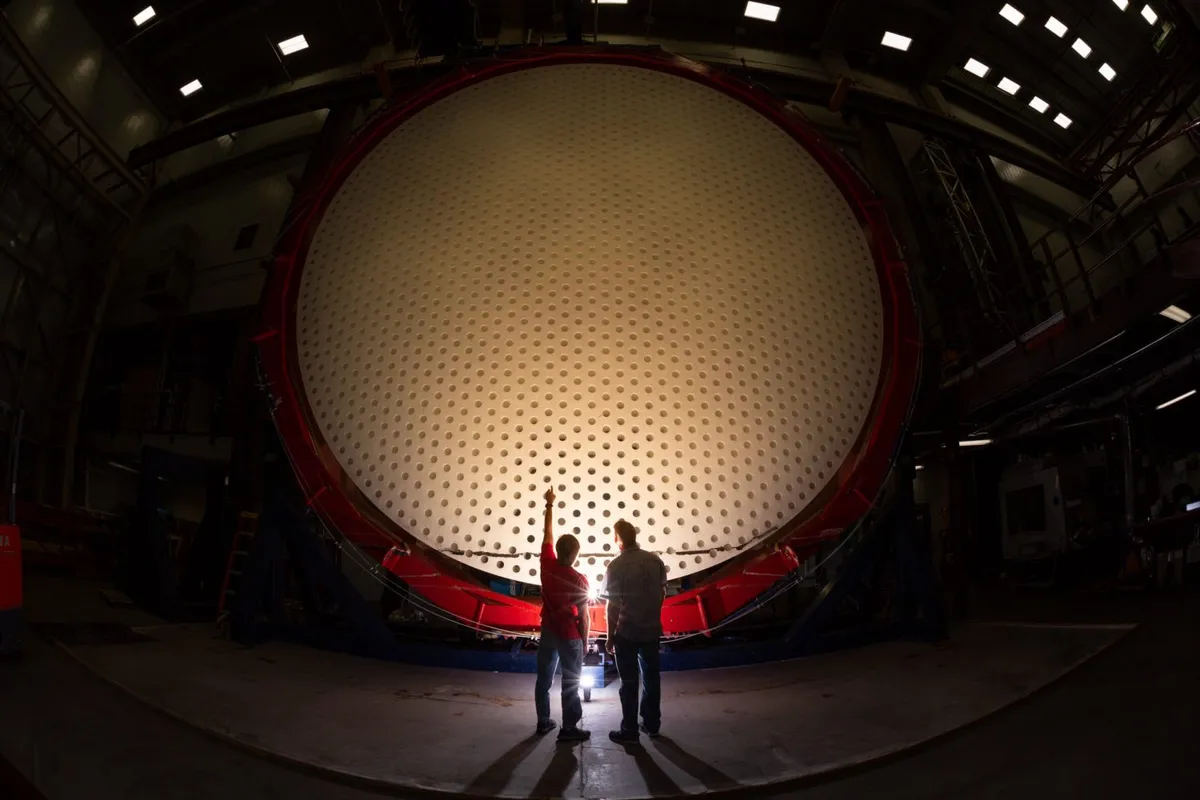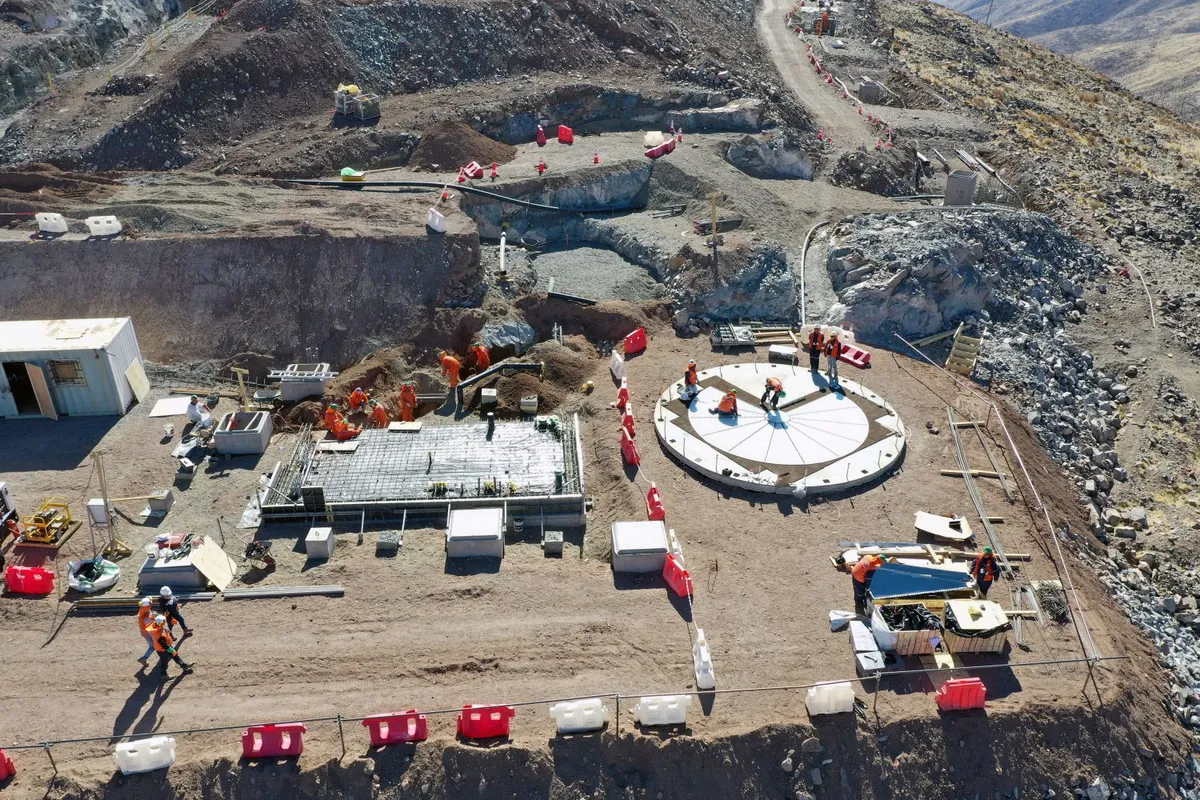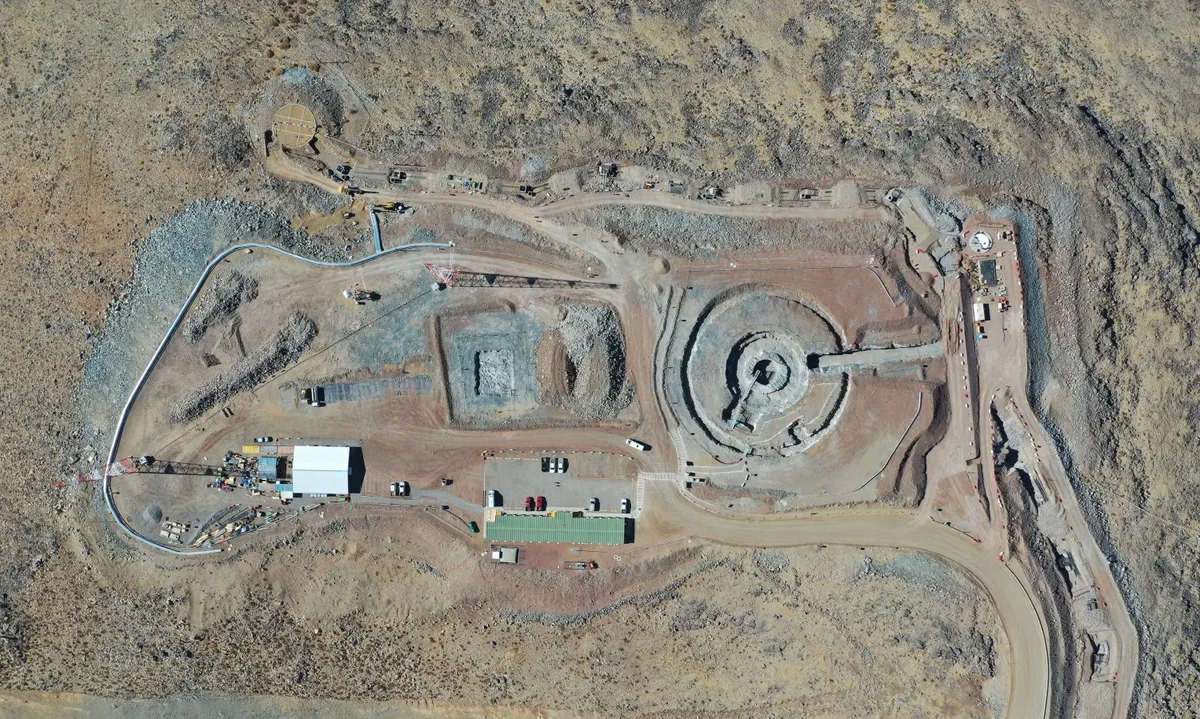In a remote part of Chile's Atacama Desert, a 65 metre-tall telescope is being constructed that will help astronomers peer back in time to the early Universe. Due to catch its first glimpse of the cosmos in 2029, the Giant Magellan Telescope (GMT) is an epic project, and one that will come to fruition over the coming decade.
The GMT is one of the next generation of ground-based telescopes, including the European Southern Observatory's Extremely Large Telescope - also sited in the Atacama Desert - that astronomers hope will help answer some of the burning existential and scientific questions of our time.
How did the Universe form? Why are there galaxies, stars and planets? Are there any other planets like our own? Are we the only intelligent life that has ever existed in the history of the Universe?
2029 may seem like a long way away, but there's plenty to be done, and constructing a huge telescope in the middle of the desert is no easy task.
We spoke to Robert Shelton, President of the Giant Magellan Telescope, to find out how the project is coming along, and how it will help astronomers answer some of the burning questions of our time.

What is the Giant Magellan Telescope, and how will it operate?
The GMT will be one of a new class of super-large, ground based telescopes working in the optical and infrared wavelengths.
It will have a collective diameter of about 25 metres, and a primary set of mirrors that consists of 7 segments, each 8.4 metres in diameter, which are the largest mirrors that can be made anywhere. These are fabricated at the Richard F Caris Mirror Lab at the University of Arizona.
Two of the mirrors are already completed. The next three have been cast and are at various stages of polishing, and we have all the materials for mirrors 6 and 7 and they’ll be cast in 2020 and 2021 collectively. So we’ve made excellent progress with the mirrors.
The telescope will be located in Chile, in the north of the country, right at the southern end of the Atacama Desert, at a place called Las Campanas Observatory. It’s an altitude of about 2,500 metres.
The whole telescope will be enclosed in a giant structure about 65 metres tall.
We are anticipating that we will have first light in 2029, and all 7 mirrors will be loaded in by 2030.
The project is very international in scope. We have 12 institutions: 8 from the US, 2 in Australia, 1 in Brazil and 1 in South Korea. These are the institutions that have funded the vast majority of the work so far.
We have cleared the site already and the complicated hard-rock excavation was completed earlier in 2019.
How do you get a 17-tonne mirror from Tucson Arizona to the top of a mountain in Chile? The answer is 'very carefully'
In 2019 we saw a number of milestones achieved. We already have sleep, dining and recreation facilities completed for the workers at the site, along with water, power and internet.
Earlier in 2019 we also issued the contract to build the guts of the telescope, which was a contract that we competed over a 2-year period and we finally selected MT Mechatronics from Mainz, Germany, and Ingersoll Machine Tools from Illinois in the US.
The telescope core is about 2,000 tonnes and will hold all the mirrors and instruments.So 2019 has been a big year!
Behind the scenes we’ve also been carrying out a rigorous external review that took place in the first half of the year with scientists and experts outside of our project and they’ve concluded that there are no scientific or technological barriers to building the GMT, and that we have a team that can do so.
So now we’re going to roll up our sleeves and see whether we can make the same progress in 2020.
Rather than one huge mirror, the telescope will have lots of smaller mirrors combined to create a larger aperture. Why was this design chosen?
That is correct. We will have 7 mirrors. Some of the other designs had hundreds of smaller hexagonal mirrors but in this case we take advantage of our partnership with the University of Arizona, which is the only place in the world that can make these 8.4 metre-diameter mirrors.
We’ll combine the 7 mirrors in a sort of flower/petal-like arrangement, including a centre one that will be a typical parabolic, concave mirror, and then 6 around the outside that are off-axis mirrors.
One of the first challenges was whether we could polish the right shape into these off-axis mirrors.
I was actually President of the University of Arizona when the first mirror-polishing was being done, and you could say it was a tense time!
But in fact it all worked and the second one was completed much faster than the first - practice makes better - and so now we are ready to go with all of the mirrors, because we’ve shown that it can be done.

Why did you choose to build the telescope in the Chilean desert?
The conditions in the Atacama Dessert are overwhelmingly the most favourable on Earth for ground-based, optical infra-red astronomy.There are a number of features that are really critical.
First of all, you have minimal water vapour because it’s very dry.Water particles absorb important parts of the electromagnetic spectrum that we’d like to observe.
It’s high, and you have a very constant wind flow coming off the ocean up by the Andes so you have minimal disturbance by the atmosphere.
The atmosphere causes our view of the Universe to wiggle, which is not good for astronomy, and so you seek to minimise that, and then you can combine it with adaptive optics techniques to take all of the wiggle out.
Finally, the infrastructure for observatories is very strong there. We estimate that by 2030 when the telescope comes online, Chile will host as much as 70% of the ground-based observing capabilities in the world.
So the Atacama Desert is an ideal location. The other thing I would say is that it’s not too high, either. It’s at about 2,500 metres so it’s still a very comfortable place for people to work.
It must be a challenge to transport everything to such a remote location.
Yes, you're absolutely right, and I will say that just about everybody I talk to eventually comes round to the question of "how do you get a 17-tonne mirror from Tucson, Arizona to the top of a mountain in Chile?"
Of course the tongue-in-cheek answer is "very carefully" but basically you put it on a special truck and you drive it to the port of Houston, and then you put it on a ship and run it down through the canal to the port of Coqimbo in northern Chile, and then you take a number of days to drive it along the highway and up into the mountain.
So yes, the assembly is done over time with great care, but one of the advantages we have in that regard is that we can start our engineering and science studies with 3 or 4 of the mirrors. We don't have to have all 7 to get started.
Once the telescope mount assembly and the enclosure are assembled up on the mountain, we will start loading in the mirrors.
We can start to do the science and then as the other mirrors are completed, they'll be shipped and loaded into the mount assembly.
We'll be able to look at exoplanets for signatures of diatomic oxygen, water vapour, methane, ozone: molecules we associate with the presence of life
The other thing is that with the excellent telecommunications in Chile, eventually there will be remote observing opportunities.
The bandwidth will be so strong that you'll be able to do remote observing from the comfort of your own laboratory.
So there is a lot more to come. We're excited about getting launched, but the lifespan of this observatory is probably close to 50 years or even longer, and it will get better over time because the instruments will get more sophisticated.
The advances in data processing and data management will allow the telescope to be even better 30 years from now than it will be when it starts.
And of course by being on the ground, we can make all those improvements at a cost that is reasonable.

That's one of the advantages over a space telescope; that you can repair and modify a ground-based telescope.
Yes, exactly. In one of my previous roles I was on the Hubble Space Telescope oversight board when Servicing Mission 4 went into play, and it was a fantastic mission that paid off big time.
But each of those missions was about a billion dollars. So when we want to add the next generation of instruments to the GMT, it won't be inexpensive but it will be tens of millions rather than a billion.
When people think of astronomy and the Atacama Desert, they'll likely think of the European Southern Observatory and ALMA. Are there any plans to collaborate with ESO?
It's very important that both the GMT and ALMA are there. I was able to go to the ground-breaking of the Extremely Large Telescope, which is about an hour's flight north of where we are.
Right now, both projects are working hard to complete their telescopes. We're in contact with each other. Each one will have certain advantages, I'm told by our astronomers, and will be able to focus on different things.
The trend now for all of these telescopes - the big ones on 8, 10-metre scales, is that once you have the data, the people who pay for and collect the data have a proprietary period to utilise it and then that data becomes public.
And so that way you have greater collaboration; sometimes you can even get amateur astronomers accessing the data and finding things that we might not otherwise.
So I envisage great collaboration once these telescopes are built.
What will the GMT be able to see, and what mysteries do you hope it will be able to solve?
The thing that gets astronomers and cosmologists really excited is that with bigger telescopes you can effectively look farther back in time.
The speed of light is fast, but it's not infinite, and so when you're looking at objects that are farther away, you're looking back in time.
With the GMT, we're able to look back within about 200 million years after the Big Bang.
So that gets cosmologists excited: understanding the origin of the Universe, the origin of the Big Bang. The moment when galaxies formed, when re-ionisiation occurred: all of these topics that will allow us to better understand how our Universe came to be.
At the other end, where everyone really gets excited is the search for life elsewhere in the Universe. We now have thousands of Earth-like exoplanets that have been discovered, but with the current suite of telescopes we're only able to identify that there is a planet.
We will hopefully find things that we didn't know about, which is of course why you do science
We don't have enough light-collecting power to determine what the atmosphere of those planets would be like.
With the GMT, we will be able to collect enough light across the whole optical infra-red spectrum so that we can determine what elements are in that spectrum.
We'll be able to look for signatures of diatomic oxygen, water vapour, methane, ozone: all of those molecules that we at least associate with the presence of life.
In fact, the first suite of instruments that our government has approved, and which are being fabricated now, are spectrographs, and they are particularly well-suited to studying the atmospheres of exoplanets.
Also, we will hopefully find things that we didn't know about, which is of course why you do science.
If you could predict everything that you were going to find, you probably wouldn't need to do the experiment! And so things will come up that we can't even imagine, I'm sure.

One of the most exciting things about something like the Hubble Space Telescope is the amazing images it captures. Will the GMT also give us images of the cosmos?
Absolutely. My background is solid state physics, condensed matter, and I used to tongue-in-cheek complain about how the astronomers had such a tremendous advantage over us because of the compelling visuals they have to encourage young people into studying astronomy.
The way you get young people interested in science is through dinosaurs or through astronomy! And the more young people we can entice into scientific careers, I think the better our lives will be.
So yes, we definitely will be focussing on capturing wonderful images.
What's left in the construction timeline between now and 2029?
Oh there's plenty to do! The important thing is, this organisation is very smart, and they tackled the high-risk questions first, such as 'can you cast and polish an of-axis mirror 8.4 metres in diameter?'
So, we're in a situation now where this kind of risk has been retired and we know how to go forward.
We still have to polish mirrors 3, 4, 5, we have to cast mirrors 6 and 7, but we have all the specialised glass for that and we know how to do it.
We have to fabricate the mount, but we now have that under contract and so we know the cost of that, we know how to go forward and we have 2 fantastic organisations to do this work.
We are going to have to let a contract for the enclosure, this 60-plus metre tall building that houses everything. Imagine a 60-metre tall building that has to rotate. That's a challenge.
There are instruments to be built. We're very far along on a number of instruments, and we have to make sure that they continue to make progress.
Then there's the adaptive optics. This is a technique that observatories use worldwide to take the wiggle that the atmosphere produces out of the image of the night sky.
We have to make sure that we fabricate our secondary mirrors, of which there will also be 7, and these are the ones that will contain the adaptive optics.
There are additional buildings to be put up at the site, including a building to coat the mirrors, as they have to be periodically re-coated.
There's still plenty to do but the infrastructure is there and the high-risk elements have all been addressed and retired.
It sounds like you've got a busy 2020 ahead of you.
Oh yes. 2020, 2021, 2022, 2023. It is exciting.
We have about 100 people in our Pasadena office and another 20 or so in Chile, and of course a lot of people under contract that are doing excavation, but they're all linked arm in arm for this one incredible project.
It's a very clear set of priorities, and it doesn't mean we don't get frustrated on occasion, but anonymity of purpose is something that is very joyful to see.
